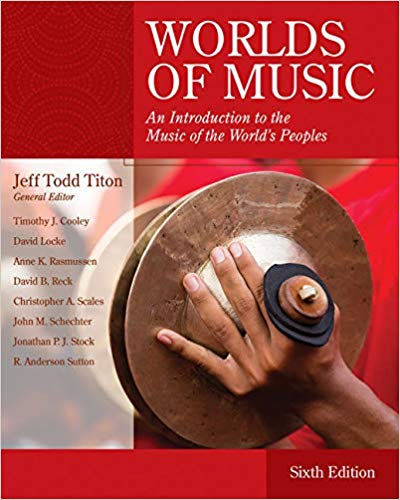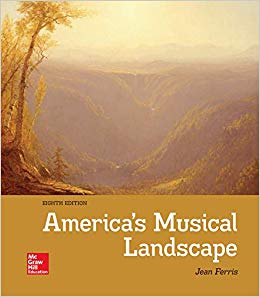Worlds of Music An Introduction to the Music Of the World’s Peoples 6th Edition by Jeff Todd Titon Test Bank
Original price was: $55.00.$20.00Current price is: $20.00.
Digital item No Waiting Time Instant Download
ISBN-13: 9781133953906 | ISBN-10: 1133953905
Edition: 6th Edition
Publisher : Cengage Learning
Author name: Jeff Todd Titon
Description
Worlds of Music An Introduction to the Music Of the World’s Peoples 6th Edition by Jeff Todd Titon Test Bank
Table of Contents
1. The Music-Culture as a World of Music.
2. North America/Native America.
3. Africa/Ewe, Mande, Dagbamba, Shona, BaAka.
4. North America/Black America.
5. Europe/Central and Southeastern Regions.
6. Asia/India.
7. Asia/Indonesia.
8. Asia/China, Taiwan, Singapore, Overseas Chinese.
9. South America/Chile, Bolivia, Ecuador, Peru.
10. The Arab World.
11. Discovering and Documenting a World of Music.
Chapter 2 : North America/Native America
|
Content Quiz |
|
1. Eskanye songs are often performed by a. ritual specialists only. b. drum groups. c. community singing societies. d. teams of singers and dancers who compete for small prizes. ANSWER: c |
|
2. Men’s Fancy dance regalia is distinguished by a. yarn fringe that is meant to invoke long prairie grass. b. a large feather bustle worn on the waist. c. two feather bustles worn on the waist and shoulders. d. a number of metal cones sewn into the outfit. ANSWER: c |
|
3. Which is not a common part of a Grand Entry at a powwow? a. a Flag song b. a Veteran’s song c. a Circle Dance song d. an invocation ANSWER: c |
|
4. The growth of Native American popular music in the 1990s was fueled by a. the establishment of several new record labels specializing in Native music. b. the rise of the Red Power movement. c. the urbanization of the Native American population. d. the establishment of the Indian Act. ANSWER: a |
|
5. Which statement most accurately describes the group XIT? a. They are an intertribal rock band that performed protest music. b. They were the first group to win a Native American Grammy. c. They do not often sing about their Native American heritage. d. The group is comprised mainly of Navajo musicians. ANSWER: a |
|
6. Which is not an description of Ndáá’ songs. a. Ndáá’ songs are the hit tunes of traditional Navajo life. b. Different kinds of war dance songs from Enemyway make up the largest body of Ndáá’ songs. c. Ndáá’ songs are also used in secular settings for recreational purposes. d. Ndáá’ songs are often sung by visiting tribal groups as part of a larger community gathering. ANSWER: d |
|
7. Common features of Ghost Dance musical style include a. the use of paired phrases. b. a narrow melodic range. c. unaccompanied solo singing. d. all of the given answers. ANSWER: a |
|
8. Which instrument(s) typically accompany Eskanye songs? a. cow horn rattle. b. water drum. c. cow horn rattle and water drum. d. none of the given answers. ANSWER: c |
|
9. Stomp dance performances are typically comprised of a variable number of songs sung one right after the other, forming a larger song “set.” a. True b. False ANSWER: True |
|
10. The Jingle Dress dance is widely believed to have originated with a. the Sioux tribes. b. the Paiute. c. the Ojibwa. d. the Iroquois. ANSWER: c |
|
11. A ________ is a traditional dwelling of the Navajo people. a. longhouse b. arbor c. hogan d. teepee ANSWER: c |
|
12. Which of these events was not associated with the Red Power movement? a. the occupation of Alcatraz island b. the Trail of Broken Treaties c. the occupation of Wounded Knee d. the protest of Bill C-31 ANSWER: d |
|
13. Which musical genre does not feature call-and-response? a. powwow music b. Ghost Dance music c. Stomp Dance music d. Eskanye songs ANSWER: b |
|
14. Round Dance songs often feature English language lyrics. a. True b. False ANSWER: True |
|
15. Which tribal group is not a member of the Iroquois Confederacy? a. the Mohawk b. the Creek c. the Cayugas d. the Senecas ANSWER: b |
|
Listening Quiz |
|
16. Name the tribal group from which this song originates. a. Yuchi b. Haudenosaunee c. Navajo d. Ojibwa ANSWER: b |
|
17. In what social context would one typically expect to hear this song performed? a. a powwow b. a curing ceremony c. a Sing d. The social part of a more deeply religious and sacred event ANSWER: c |
|
18. What is the context for this performance? a. a powwow b. the Nightway ceremony c. a Song and Dance d. a Stomp dance ANSWER: d |
|
19. In this example, formal and melodic unity is achieved by the music’s ________. (Hint: What does “unity” mean when applied to form and melody in music?) a. use of male singers b. repetition of phrases c. quick tempo d. strong duple meter ANSWER: b |
|
20. The cultural context of this selection lies in a. preparing for war. b. a grandchild’s lullaby. c. praying for the return of dead ancestors. d. curing a sick person. ANSWER: d |
|
21. A prominent feature in the melody in this selection is a. a downward leaping contour. b. a simple two-note motive repeated over and over. c. an upward leaping contour. d. the absence of melodic repetition. ANSWER: c |
|
22. Name the musical genre of this selection. a. Peyote song b. Stomp Dance song c. Powwow song d. Ghost Dance song ANSWER: d |
|
23. The texture of this example is a. monophonic. b. homophonic. c. polyphonic. d. heterophonic. ANSWER: a |
|
24. What is NOT a musical feature of this song? a. a terraced, descending melodic line. b. a high, tense vocal production. c. call and response. d. triple meter. ANSWER: d |
|
a. a ghost dance song. b. Northern style singing. c. Southern style singing. d. a peyote song. ANSWER: b |
|
26. Where would one typically expect to hear this song? a. an Enemyway ceremony. b. a powwow. c. a Sing. d. a potlatch. ANSWER: b |
|
27. Name the genre of this selection. a. Circle Dance song b. Straight song c. Women’s Shuffle Dance song d. Round Dance song ANSWER: d |
|
28. The solo instrument in this selection a. enters at the very beginning of the selection. b. enters after about 15 seconds. c. enters after about 30 seconds. d. is absent; (there is no solo instrument). ANSWER: b |
|
29. The lyrics of this music describe a. the philosophy of Red Power. b. the peyote road. c. how Native Americans experienced boarding schools. d. how the Indian Act affects the lives of Native peoples. ANSWER: c |
|
30. The form of this song is a. a modified blues form with a verse and a chorus. b. call and response. c. through-composed. d. none of the given answers. ANSWER: a |





Be the first to review “Worlds of Music An Introduction to the Music Of the World’s Peoples 6th Edition by Jeff Todd Titon Test Bank”